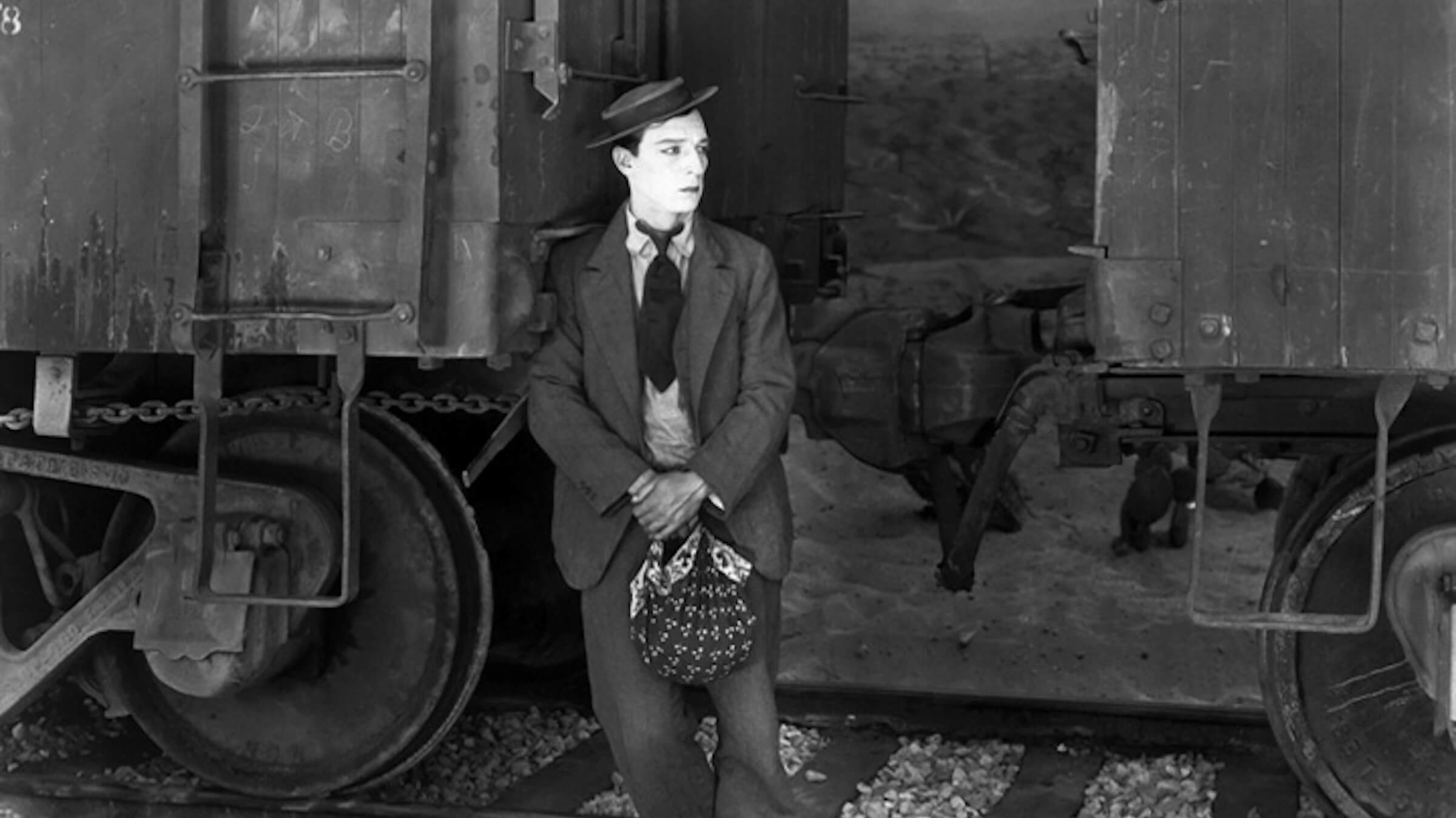Go West was an unusual film for Buster Keaton. With its portrayal of a down-and-out wanderer who becomes a reluctant hero, Go West could have been a vehicle for Charlie Chaplin’s Little Tramp. While the film wasn’t one of Keaton’s personal favorites, it was praised by critics and did well at the box office. Much of it was shot on location in Kingman, Arizona, during the summer of 1925, in temperatures approaching 120 degrees. Keaton used the opportunity to debunk the legend of the American Wild West, which had taken on mythic proportions in the early 20th century.
The legend of Buster Keaton begins with traveling medicine-show performers Joe and Myra Keaton. On October 4, 1895, in Piqua, Kansas, Myra delivered a son named Joseph Frank Keaton. Like much American lore, the saga of Buster Keaton’s early life is full of exaggerations and fabrications. Keaton’s father told one such tale about baby Buster being sucked up by a tornado then returned to earth safely. When Marion Meade wrote her 1995 biography Buster Keaton: Cut to the Chase, she discovered that, while there was a record of a storm during the month the incident supposedly happened, there were no reported tornados.
Keaton spent most of his young life appearing in his parents’ act as “The Child That Cannot Be Damaged,” the highlight being a violent slapstick routine featuring Joe tossing Buster around the stage as if the boy were a rag doll. The novelty of a child who neither laughed nor cried while being used as a human mop catapulted the Keatons to vaudeville success and also attracted the attention of New York’s Society for the Prevention of Cruelty to Children, which tried to keep the Keatons from performing in that state. Keaton’s renowned “stone face” expression may have been the result of learned behavior, that he was taught as a child he would be rewarded for not exhibiting natural reactions to his father’s violence. By today’s standards, Buster would be considered an abused child.
In 1917 the Keatons dissolved the act, and Buster, now 21 years old, set out on his own. Invited by a fellow vaudevillian to visit the Comique Film Corporation in Manhattan, Keaton met Roscoe “Fatty” Arbuckle, who was making a two-reel comedy, The Butcher Boy. Arbuckle recognized Keaton and asked him if he wanted to play a small part in the film. Keaton joined the cast and was outfitted for the first time with his trademark porkpie hat. The next day, Keaton became a member of Arbuckle’s company. Together they moved to Hollywood and made 15 two-reel shorts between 1917 and 1920. Keaton always said it was Roscoe Arbuckle who taught him everything about film comedy.
When Arbuckle signed a new contract with Famous Players-Lasky Productions in 1920, Comique’s owner Joseph Schenck made Buster his new star. In 1922, the company was renamed Buster Keaton Productions, although Schenck still controlled the purse strings. Keaton produced 19 shorts for Schenck between 1920 and 1923.
Keaton’s vaudeville background gave him knowledge of stage tricks that worked well on film, and his interest in the mechanics of moviemaking enabled him to create tricks that still amaze audiences. In The Playhouse (1921), Keaton played several roles, courtesy of multiple exposure photography. In one scene, Keaton plays every person in a vaudeville theater.
In 1923, Keaton began making features. As long as the films made money, producer Schenck gave him carte blanche. Keaton’s filmmaking process started with a rough story idea, sets, props, a cast, and crew. It finished with a complete film. In between, there was a great deal of improvisation and baseball games. While many gags, such as the collapse of the train bridge in The General, were carefully planned and executed in one take, it wasn’t unusual for Keaton to invent entire comic routines while filming. A scene in The Three Ages (1923), in which Keaton uses a club as a bat to hit a line drive into a rival’s forehead, required 52 takes. This independent approach caused friction for Keaton when Schenck folded the company in 1928 and Keaton became a contract player at Metro-Goldwyn-Mayer.
Beginning with The Cameraman (1928), the studio placed Keaton under the supervision of Lawrence Weingarten, the brother-in-law of MGM president Irving Thalberg. Keaton was gradually transformed from a filmmaker into an actor. Ultimately, MGM tried to make him part of a comedy duo, pairing him with Jimmy Durante for three features: The Passionate Plumber (1932), Speak Easily (1932) and What! No Beer? (1933). They proved to be his last films at MGM.
As Keaton found himself out of fashion in the industry, his personal life was also suffering. He had become an alcoholic. His marriage to Natalie Talmadge (sister of silent film stars Norma and Constance) ended in divorce in 1932. Talmadge won custody of their two sons, whom she promptly rechristened with her surname. And Keaton discovered, at the height of the Depression, that he had all but exhausted his financial resources. In 1940, his fortunes reversed when he met and married Eleanor Norris, a 20-year-old MGM contract player. They remained happy together for the rest of his life, living in a modest home in Woodland Hills, California. He also became reacquainted with his sons, though they continued to use the Talmadge surname.
In 1954, Keaton and Eleanor attended a rare screening of The General in Los Angeles. The theater’s manager, Raymond Rohauer, introduced himself to Keaton and was offered the opportunity to take control of film prints housed in Keaton’s garage. Rohauer’s aggressive preservation efforts (he engaged in several bitter copyright disputes) led to a revival of Keaton’s earlier films. At the 1965 Venice Film Festival in Italy, Keaton received a 20-minute standing ovation. In 1966, he died at the age of 71.
Presented at SFSFF 2003 with live music by Dennis James on the Mighty Wurlitzer

